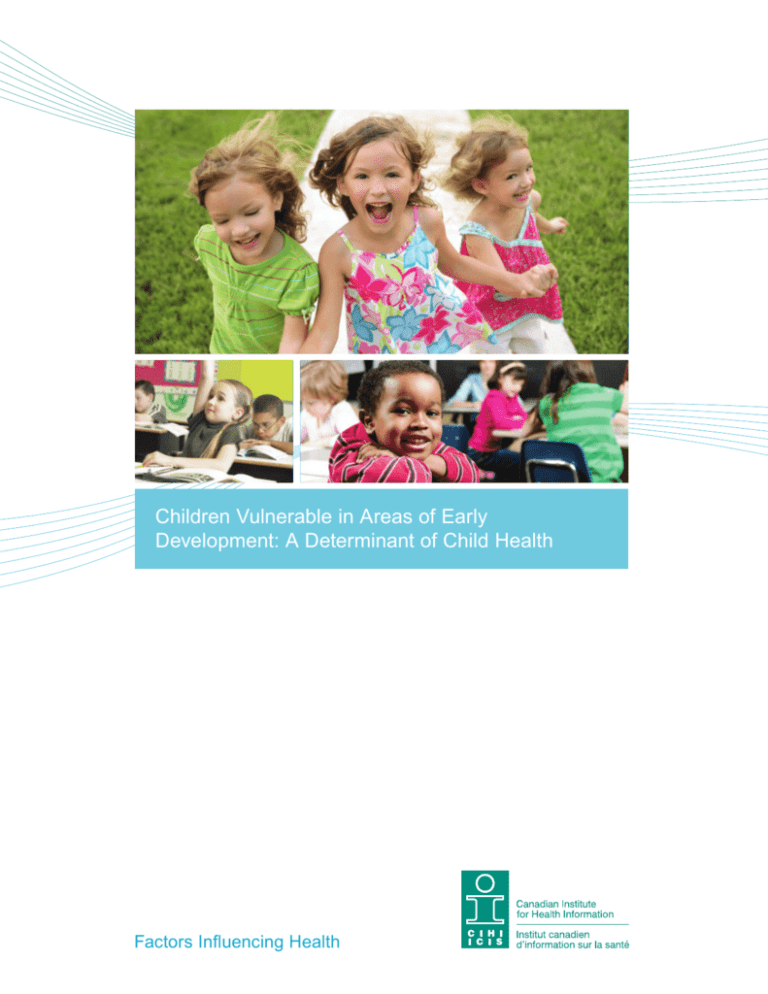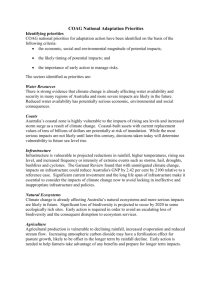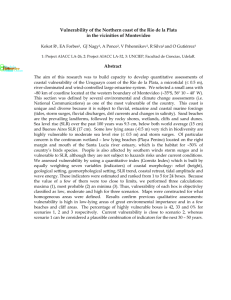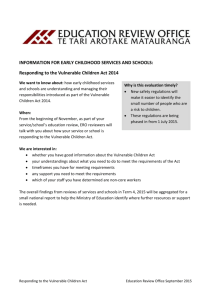
Children Vulnerable in Areas of Early
Development: A Determinant of Child Health
Factors Influencing Health
Our Vision
Better data. Better decisions.
Healthier Canadians.
Our Mandate
To lead the development and
maintenance of comprehensive
and integrated health information
that enables sound policy and
effective health system management
that improve health and health care.
Our Values
Respect, Integrity, Collaboration,
Excellence, Innovation
Table of Contents
Introduction .................................................................................................................................4
Healthy Development: Good for Children, Good for Society ..................................................4
Measuring Child Vulnerabilities .............................................................................................5
Canada’s EDI Score ...................................................................................................................6
Vulnerability Rates Across Provinces and Territories ............................................................7
Association Between Income and Vulnerability Rates ...........................................................8
Areas of Vulnerability for Canadian Children .........................................................................9
How Do Early Interventions Support Early Child Development? ..........................................12
What Is Happening in Canada to Improve Early Child Development? .................................13
References ...............................................................................................................................14
Children Vulnerable in Areas of Early Development: A Determinant of Child Health
Introduction
The indicator Children Vulnerable in Areas of Early
Development is a reflection of health and well-being
among 5-year-olds (the average age of children in
kindergarten). It measures developmental outcomes
and milestones achieved during the first five years of
life within the context of early experiences. It is also an
important determinant of health and well-being in later
life. How children develop as they grow depends on
many factors, such as prenatal and postnatal
environments, effective parenting, and the social and
economic circumstances in which a child lives and
grows up. Research shows that all of these factors
have a vital impact on the way the brain develops.
Early life experiences affect a person’s learning skills,
coping skills, resiliency and even overall health as
an adult.
Healthy Development: Good for
Children, Good for Society
As a leading source of reliable, comparable
and timely health information in Canada,
the Canadian Institute for Health Information
(CIHI) has embarked on an initiative to
strengthen its work on pan-Canadian health
system performance reporting to better
support jurisdictions’ efforts to improve care
and the health of Canadians. This initiative is
based on the Health System Performance
Measurement Framework, which
demonstrates how indicators interconnect and
relate to one another, and how they contribute
to overall performance goals for provinces
and territories, such as improved health status
and better value for money. The framework
is based on the relationship between four
main quadrants: health system inputs, health
system outputs, social determinants of health
and health system outcomes.
Children Vulnerable in Areas of Early
Development, as measured using data
collected by the Early Development
Instrument, informs the health system
outcomes quadrant of the framework, which
reflects on the health status of Canadians.
While reported as a measure of health
outcomes (or how well children are doing
now), it is also an important determinant of
health (or a measure of how well children
might do in the future).
Children who are exposed to optimal environments
early in life have the best opportunities to grow up
healthy and happy. On the other hand, adverse
experiences early in a child’s life—if not addressed—
can lead to poor health (obesity, cardiovascular
disease and diabetes), poor educational attainment,
economic dependency, increased violence and crime,
greater substance abuse and depression. All of these
add to the burden and cost to society, including the
health system.1, 2 Research shows that limiting exposure to risk and promoting protective factors
in early years can reduce the need for more costly interventions later in life.3, 4 Positive
interventions in early childhood can also help mitigate the impact of adverse experiences.
Ensuring healthy child development leads to a country’s sustainable development and is one
of the most cost-effective investments in human capital that a country can make.3, 4 Literature
shows that there is a 7:1 return on public investment for programs for young children compared
with a 1:1 payback from adult education.5 On a global level, those societies—rich or poor—that
invest in children in their early years have the most literate populations, the best health status
and the lowest levels of health inequality in the world.2, 6
4
Children Vulnerable in Areas of Early Development: A Determinant of Child Health
Our childhood years represent a critical stage that most strongly impact the rest of our lives, and where the greatest
opportunity for positive influence lies.
—David Butler Jones, Canada’s Chief Public Health Officer, in Report on The State of Public Health in Canada 2009
Measuring Child Vulnerabilities
The indicator Children Vulnerable in Areas of Early Development is measured using the Early
Development Instrument (EDI),7, 8 a tool that is widely used around the world to monitor the
state of early child development. The EDI is a kindergarten teacher–completed checklist that
measures a child’s performance in five general areas of development:
1.
Physical Health and Well-Being;
2.
Social Competence;
3.
Emotional Maturity;
4.
Language and Cognitive Development; and
5.
Communication Skills and General Knowledge.
Developed in 1999 by McMaster University’s Offord Centre for Child Studies, the EDI provides
population-based information on key dimensions of children’s development that relate to their
readiness to learn at school and their ability to meet the task demands of school (including playing
and working with other children, listening to the teacher, remembering and following rules, and
being comfortable exploring and asking questions). Recent longitudinal studies have indicated
that early child development measured using EDI is a strong predictor of success in later life.9–12
How Is This Indicator Calculated?
This indicator is calculated by dividing the number of children who are vulnerable on at least
one area of development by the total number of children with valid EDI data; it is reported based
on the school year, from September to June. The EDI data collection periods for the provinces/
territories included in this report are outlined in Table 1.
Table 1: EDI Data Collection Periods for This Report, by Province/Territory
Province/Territory
Data Collection Period
P.E.I.
2007–2008
2008–2009
2011–2012
N.B.
Que.
Ont.
Man.
Sask.
B.C.
Y.T.
2009–2010 to 2011–2012
2010–2011
2008–2009 to 2010–2011
2009–2010 to 2010–2011
2011–2012
Source
Offord Centre for Child Studies, McMaster University.
5
Children Vulnerable in Areas of Early Development: A Determinant of Child Health
A child is considered vulnerable when his or her EDI score for an area of development is equal
to or lower than the score corresponding to the 10th percentile of all kindergarten children for
that area of development. Children who are vulnerable in areas of early development are more
likely to face greater challenges in school learning than those who are not vulnerable. A lower
percentage of children considered vulnerable at school entry is a positive indicator of healthy
development at age 5.
Canada’s EDI Score
The majority of children in Canada are doing well on each of
the five EDI areas of development. Overall in Canada, one
in four children (26%) is vulnerable in one or more areas of
development prior to entering Grade 1.
Girls were less likely to be vulnerable at age 5 than boys.
According to data from the Offord Centre, 33% of boys in
Canada were vulnerable on one or more areas of development,
compared with 19% of girls.
Figure 1: Children Vulnerable in at Least One Area of Development at Age 5,
by Sex (Percentage)
Notes
A higher percentage indicates greater vulnerability.
For data years, please see Table 1.
Source
Offord Centre for Child Studies, McMaster University.
6
Children Vulnerable in Areas of Early Development: A Determinant of Child Health
Vulnerability Rates Across Provinces and Territories
The rate of vulnerability in one or more areas of development varied across Canada. For example,
Yukon and B.C. had higher vulnerability rates (a higher proportion of children measured as
vulnerable) than the Canadian average, whereas the vulnerability rates for P.E.I. and Ontario
were lower than the Canadian average (a lower proportion of children measured as vulnerable).
Figure 2: Children Vulnerable in at Least One Area of Development at Age 5,
by Province/Territory (Percentage)
Notes
Provincial/territorial analysis is available for only those jurisdictions that have complete province-/territory-wide coverage and have
participated in this analysis.
For data years, please see Table 1.
Source
Offord Centre for Child Studies, McMaster University.
Variations in how (and how often) the EDI is administered might affect provincial/territorial
comparisons. While some provinces (e.g., P.E.I., New Brunswick) administered the EDI in the
entire province in one year, other provinces (e.g., B.C., Ontario) used a phased approach. For
example, it took two years in B.C. and three years in Ontario to complete data collection for the
entire province. This variability in data collection means that the time period is not uniform when
making comparisons across jurisdictions.
7
Children Vulnerable in Areas of Early Development: A Determinant of Child Health
Association Between Income and Vulnerability Rates
Early child health outcomes are positively associated with indicators of socio-economic status,
such as income.13 This is partially attributed to the fact that low-income families usually
experience a number of disadvantages that would impact the home environment and the
quality of childrearing.
Figure 3: Children Vulnerable in at Least One Area of Development at Age 5,
by Income Quintile (Percentage)
Notes
A higher percentage indicates greater vulnerability.
For data years, please see Table 1.
Source
Offord Centre for Child Studies, McMaster University.
The data shows that lower neighbourhood income is associated with higher vulnerability (poorer
EDI scores). Children in low-income neighbourhoods showed a higher rate of vulnerability (34.9%)
than those in high-income neighbourhoods (19.5%). i
i. Neighbourhood income quintiles are determined using each child’s home postal code and Statistics Canada’s Postal Code
Conversion File+. The distribution of neighbourhood income is divided into five categories (quintiles), where approximately 20% of
the neighbourhoods fall into each category. The lowest income quintile category is assigned to represent those neighbourhoods in
the lowest 20% of the distribution of neighbourhood income. Those in the highest income quintile represent the neighbourhoods in
the highest 20% of the distribution.
8
Children Vulnerable in Areas of Early Development: A Determinant of Child Health
Areas of Vulnerability for Canadian Children
Evaluating data gathered using the EDI questionnaire also lets us measure vulnerability by area
of development.
Figure 4: Areas of Vulnerability Among Children Vulnerable in at Least One Area of
Development, Canada (Percentage)
Notes
A higher percentage indicates greater vulnerability.
For data years, please see Table 1.
Source
Offord Centre for Child Studies, McMaster University.
The area Communication Skills and General Knowledge stands out as the one that had the
greatest vulnerability among children vulnerable on at least one area of development. Nearly
half of the children who had some (one or more) vulnerability were vulnerable in this area.
Language and Cognitive Development was the area with the lowest vulnerability rates.
9
Children Vulnerable in Areas of Early Development: A Determinant of Child Health
Table 2: Areas of Vulnerability Among Children Vulnerable in at Least One Area of Development,
by Province/Territory (Percentage)
Communication
Skills and General
Knowledge
Emotional
Maturity
Language and
Cognitive
Development
Physical Health
and Well-Being
Social
Competence
P.E.I.
31.2
45.5
30.7
28.0
37.6
N.B.
38.8
52.9
25.5
36.8
40.7
Que.
33.4
53.5
36.6
28.4
30.5
Ont.
47.3
41.5
25.8
38.0
37.3
Man.
49.4
39.6
38.0
37.2
35.0
Sask.
46.4
37.3
40.5
46.8
31.7
B.C.
47.8
44.1
29.2
46.3
36.3
Y.T.
37.4
51.2
12.2
61.8
23.6
Notes
Bold numbers indicate areas of highest vulnerability for the province/territory.
For data years, please see Table 1.
Source
Offord Centre for Child Studies, McMaster University.
Levels of vulnerability across areas of development varied by province/territory. Children in
Ontario, Manitoba and B.C. had the highest vulnerability rates in the area Communication Skills
and General Knowledge. Children in Quebec and the two Atlantic provinces for which data
was available (New Brunswick and P.E.I.) had high vulnerability rates for Emotional Maturity,
whereas children in Saskatchewan and Yukon had high vulnerability rates for Physical Health
and Well-Being.
10
Children Vulnerable in Areas of Early Development: A Determinant of Child Health
Figure 5: Areas of Vulnerability Among Children Vulnerable in at Least One Area of
Development, by Sex (Percentage)
Notes
Bold numbers indicate areas of highest vulnerability for boys and girls.
For data years, please see Table 1.
Source
Offord Centre for Child Studies, McMaster University.
National data suggests that boys who were vulnerable in at least one area of development had the
highest vulnerability rate in Emotional Maturity (50.9% of boys were vulnerable in this area), while
girls had the highest vulnerability rate in Communication Skills and General Knowledge (45.2%).
11
Children Vulnerable in Areas of Early Development: A Determinant of Child Health
Figure 6: Areas of Vulnerability Among Children Vulnerable in at Least One
Area of Development, by Lowest and Highest Neighbourhood Income
Quintiles (Percentage)
Notes
Bold numbers indicate areas of highest vulnerability for the lowest-income and highest-income neighbourhoods.
For data years, please see Table 1.
Source
Offord Centre for Child Studies, McMaster University.
Vulnerability in areas of development also differed across income quintiles. Communication Skills
and General Knowledge was the area of highest vulnerability among children in low-income
neighbourhoods (49.7%), whereas Emotional Maturity was the area of highest vulnerability
for children from high-income neighbourhoods (46.5%).
How Do Early Interventions Support Early Child Development?
Evidence suggests that policies that strengthen the foundations of health in early childhood may
have long-lasting positive effects.14 Here are some examples of how data on early childhood
development is being used to identify the early life determinants or predictors of school
readiness to eventually inform decision-making:
• Reading to children and having a regular bedtime positively affect development.15 A study in
Canada found that reading to children daily was associated with better language development
in children. Low-income families are less likely to engage in these activities. In all income
groups, children who were read to daily had better receptive vocabulary scores than those
who were not.16
12
Children Vulnerable in Areas of Early Development: A Determinant of Child Health
• Low family income is associated with poorer EDI outcomes at both the individual and
neighbourhood levels. An analysis from the Manitoba Centre for Health Policy showed
that the odds of EDI vulnerability were 1.7 times greater for children in families on income
assistance than for those in families not on income assistance.12
• Breastfeeding has a protective effect in reducing vulnerability. According to an analysis by
the Manitoba Centre for Health Policy, children who were breastfed had reduced odds of
being vulnerable (odds ratio = 0.86).12
What Is Happening in Canada to Improve Early Child Development?
Each of Canada’s 14 jurisdictions—the 10 provinces, 3 territories and federal government—
has a defined approach to early childhood development with the goals of providing care and
education to children, supporting parents and, more specifically, ameliorating the effects of
poverty. Here are some of the early child development investments being made across Canada:
• Ontario Early Years Centres offer services for new parents and children to support healthy
child development and early detection of any developmental concerns. The centres offer
programs on prenatal education and parenting skills for parents, as well as early learning and
literacy programs for children up to the age of 6.17
• Early intervention services in B.C. provide community-based physiotherapy, occupational
therapy, speech–language pathology and family support worker services for children from
birth to school entry who have, or are at risk for, a developmental delay and/or disability.18
• As part of its action plan to reduce poverty, Newfoundland and Labrador has invested in
early years to ensure all children develop to their full potential. The province has invested
$1.3 million to make quality child care more affordable for low-income families and to provide
these families with the support and services they need.19
These and other initiatives that are being implemented in Canada and around the world promote
early child development at a population level. The indicator Children Vulnerable in Areas of
Early Development, measured using the EDI, is the first population-level measure of school
readiness. Improving knowledge of such measures is essential for mobilizing community action
to improve children’s health and development.12
For regional analyses of this indicator, visit Your Health System at http://yourhealthsystem.cihi.ca.
For more information on the EDI, see the Offord Centre for Child Studies’ School Readiness to
Learn (SRL) Project at www.offordcentre.com/readiness.
13
Children Vulnerable in Areas of Early Development: A Determinant of Child Health
References
1.
Chan M. Linking child survival and child development for health, equity, and sustainable
development. Lancet. 2013;381(9877):1514-1515.
2.
Irwin LG, Siddiqi A, Hertzman C. Early Child Development: A Powerful Equalizer. Final
Report for the World Health Organization’s Commission on the Social Determinants of
Health. Vancouver, BC: University of British Columbia; 2007.
3.
Karoly LA, Greenwood PW, Everingham SS, et al. Investing in Our Children: What We
Know and Don’t Know About the Costs and Benefits of Early Childhood Interventions.
Santa Monica, US: RAND; 1998.
4.
VanLandeghem K, Curtis D, Abrams M. Reasons and Strategies for Strengthening
Childhood Development Services in the Healthcare System. Portland, US: National
Academy for State Health Policy; 2002.
5.
Pascal CE. With Our Best Future in Mind: Implementing Early Learning in Ontario. Toronto,
ON: Queen’s Printer for Ontario; 2009.
6.
Heckman JJ. The case for investing in disadvantaged young children. In: First Focus, ed.
Big Ideas for Children: Investing in Our Nation’s Future. Washington, DC, US: First Focus;
2008:49-58.
7.
Janus M, Brinkman S, Duku E, et al. The Early Development Instrument: Population-Based
Measure for Communities. Hamilton, ON: Offord Centre for Child Studies, McMaster
University; 2006.
8.
Janus M, Offord D. Development and psychometric properties of the Early Development
Instrument (EDI): a measure of children’s school readiness. Can J Behav Sci. 2007;39(1):1-22.
9.
Brinkman S, Gregory T, Harris J, Hart B, Blackmore S, Janus M. Associations between the
early development instrument at age 5, and reading and numeracy skills at ages 8, 10 and
12: a prospective linked data study. Child Indic Res. 2013;6(4):695-708.
10. Lloyd JE, Hertzman C. From kindergarten readiness to fourth-grade assessment:
longitudinal analysis with linked population data. Soc Sci Med. 2009;68(1):111-123.
11. Lloyd JEV, Irwin LG, Hertzman C. Kindergarten school readiness and fourth-grade literacy
and numeracy outcomes of children with special needs: a population-based study.
Educational Psychology. 2009;(5):583-602.
12. Santos R, Brownell M, Ekuma O, Mayer T, Soodeen R-A. The Early Development Instrument
(EDI) in Manitoba: Linking Socioeconomic Adversity and Biological Vulnerability at Birth to
Children’s Outcomes at Age 5. Winnipeg, MB: Manitoba Centre for Health Policy; 2012.
http://mchp-appserv.cpe.umanitoba.ca/deliverablesList.html. Accessed August 28, 2014.
14
Children Vulnerable in Areas of Early Development: A Determinant of Child Health
13. Brooks-Gunn J, Duncan GJ, Britto PR. Are socioeconomic gradients for children similar to
those for adults?: achievement and health of children in the United States. In: Keating DP,
Hertzman C, eds. Developmental Health and the Wealth of Nations: Social, Biological, and
Educational Dynamics. New York, US: Guildford Press; 1999:94-124.
14. Center on the Developing Child at Harvard University. The Foundations of Lifelong
Health Are Built in Early Childhood. Cambridge, US: Center on the Developing Child
at Harvard University; 2010. http://developingchild.harvard.edu/index.php/resources/
reports_and_working_papers/foundations-of-lifelong-health/. Accessed August 28, 2014.
15. Marmot M, Allen J, Goldblatt P, et al. Fair Society, Healthy Lives: The Marmot Review.
London, UK: The Marmot Review; 2010. www.ucl.ac.uk/marmotreview. Accessed
August 28, 2014.
16. Thomas EM. Readiness to Learn at School Among Five-Year-Old Children in Canada.
Ottawa, ON: Statistics Canada; 2006.
17. Ontario Ministry of Children and Youth Services. Ontario’s Early Childhood Development
Investments and Outcomes: 2002–2003 Annual Report. Toronto, ON: Ministry of Children
and Youth Services; 2003.
18. Ministry of Children and Family Development. British Columbia’s Early Years Annual
Report 2011/2012. Vancouver, BC: Ministry of Children and Family Development; 2012.
19. Poverty Reduction Strategy, Department of Human Resources, Labour and Employment.
Empowering People–Engaging Community–Enabling Success: First Progress Report on
the Government of Newfoundland and Labrador’s Poverty Reduction Strategy. St. John’s,
NL: Department of Human Resources, Labour and Employment; 2009.
15
Production of this document is made possible by financial contributions from
Health Canada and provincial and territorial governments. The views expressed
herein do not necessarily represent the views of Health Canada or any provincial
or territorial government.
All rights reserved.
The contents of this publication may be reproduced unaltered, in whole or in part
and by any means, solely for non-commercial purposes, provided that the Canadian
Institute for Health Information is properly and fully acknowledged as the copyright
owner. Any reproduction or use of this publication or its contents for any commercial
purpose requires the prior written authorization of the Canadian Institute for Health
Information. Reproduction or use that suggests endorsement by, or affiliation with,
the Canadian Institute for Health Information is prohibited.
For permission or information, please contact CIHI:
Canadian Institute for Health Information
495 Richmond Road, Suite 600
Ottawa, Ontario K2A 4H6
Phone: 613-241-7860
Fax: 613-241-8120
www.cihi.ca
copyright@cihi.ca
ISBN 978-1-77109-312-5 (PDF)
© 2014 Canadian Institute for Health Information
How to cite this document:
Canadian Institute for Health Information. Children Vulnerable in Areas of Early
Development: A Determinant of Child Health. Ottawa, ON: CIHI; 2014.
Cette publication est aussi disponible en français sous le titre Enfants vulnérables
dans certains domaines de la petite enfance : un déterminant de la santé
des enfants.
ISBN 978-1-77109-313-2 (PDF)
Talk to Us
CIHI Ottawa
495 Richmond Road, Suite 600
Ottawa, Ontario K2A 4H6
Phone: 613-241-7860
CIHI Montréal
1010 Sherbrooke Street West, Suite 300
Montréal, Quebec H3A 2R7
Phone: 514-842-2226
CIHI Toronto
4110 Yonge Street, Suite 300
Toronto, Ontario M2P 2B7
Phone: 416-481-2002
CIHI St. John’s
140 Water Street, Suite 701
St. John’s, Newfoundland and Labrador A1C 6H6
Phone: 709-576-7006
CIHI Victoria
880 Douglas Street, Suite 600
Victoria, British Columbia V8W 2B7
Phone: 250-220-4100
8549-09/14
www.cihi.ca
At the heart of data









